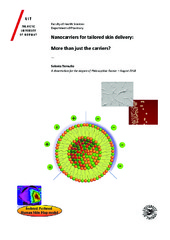Nanocarriers for tailored skin delivery: More than just the carriers?
| dc.contributor.advisor | Skalko-Basnet, Natasa | |
| dc.contributor.author | Ternullo, Selenia | |
| dc.date.accessioned | 2021-12-18T23:18:15Z | |
| dc.date.available | 2021-12-18T23:18:15Z | |
| dc.date.issued | 2018-11-23 | |
| dc.description.abstract | Skin diseases are among the top 5 most leading diseases causing non-fatal health burden worldwide and strategies to assure more effective treatments are urgently needed. Dermal therapy is very attractive due to the direct administration of the drug at the diseased skin site thus minimizing systemic side effects associated with the oral and parenteral routes. However, the great variety within the skin conditions can be a challenge in the development of effective dermal therapies. Based on the skin disease, the drug action is often required at different depths within the skin. The failure to penetrate the skin layers might result in sub-therapeutic drug levels at the targeted skin site and unsuccessful treatments. Phospholipid-based nanocarriers have great potential to overcome the current limitations in dermal therapy by assuring controlled and sustained drug delivery and promoting drug/substance transport in the deeper skin layers. The nanocarrier properties can be tailored and exploited to optimize skin drug delivery. In the present study we optimized nanocarriers for tailored skin drug delivery. A closer-to-in vivo skin penetration model was developed to select nanocarriers with specific skin-targeted drug delivery potential. Deformable liposomes were found the most promising nanocarriers delivering model substances in the deeper skin layers while avoiding systemic absorption. Further optimization of the selected nanocarrier was performed by exploring the effect of the liposomal surface charge on dermal delivery. The sustained skin penetration of drug/active substances for liposomally-associated drugs/substances was influenced by both the liposomal surface charge and physicochemical properties of the nanocarrier-associated drug/substance. The enhancement of the biological activities of both human epidermal growth factor and curcumin when incorporated in the liposomal system as compared to both active substances in solutions was found to be dependent on the liposomal surface charge. Positively charged deformable liposomes embedded in chitosan hydrogel enabled stable bioadhesive hydrogel providing a sustained skin penetration of curcumin. The developed liposomal hydrogel formulation has a potential to be further evaluated as advanced wound dressing. | en_US |
| dc.description.doctoraltype | ph.d. | en_US |
| dc.description.popularabstract | Localized drug action is expected to improve therapeutic outcome of many diseases, including skin therapy. The optimization of nanocarriers that can carry the drug into the targeted skin layers in a controllable manner leads to improvement in therapy. In this PhD project, different lipid nanoparticles were tested as nanocarriers on the skin model developed to closely mimic the living human skin. Elastic spherical vesicles, deformable liposomes, were found to be the most promising nanocarriers delivering the active compounds in the deeper skin layers while avoiding systemic absorption. By exploring the effect of vesicle surface charge, a sustained dermal delivery of the active substances was achieved and their biological activities, such as anti-inflammatory and anti-bacterial, enhanced. Positively charged deformable liposomes in chitosan hydrogel were proposed as advanced wound dressing able to assure prolonged drug localization at the administration site. | en_US |
| dc.identifier.uri | https://hdl.handle.net/10037/23436 | |
| dc.language.iso | eng | en_US |
| dc.publisher | UiT The Arctic University of Norway | en_US |
| dc.publisher | UiT Norges arktiske universitet | en_US |
| dc.relation.haspart | <p>Paper I: Ternullo, S., de Weerd, L., Flaten, G.E., Holsæter, A.M. & Škalko‐Basnet, N. (2017). The isolated perfused human skin flap model: A missing link in skin penetration studies? <i>European Journal of Pharmaceutical Sciences, 96</i>, 334-341. Also available at <a href=https://doi.org/10.1016/j.ejps.2016.10.003>https://doi.org/10.1016/j.ejps.2016.10.003</a>. <p>Paper II: Ternullo, S., de Weerd, L., Holsæter, A.M., Flaten, G.E. & Škalko-Basnet, N. (2017). Going skin deep: A direct comparison of penetration potential of lipid‐based nanovesicles on the isolated perfused human skin flap model. <i>European Journal of Pharmaceutics and Biopharmaceutics, 121</i>, 14-23. Also available at <a href= https://doi.org/10.1016/j.ejpb.2017.09.006> https://doi.org/10.1016/j.ejpb.2017.09.006</a>. <p>Paper III: Ternullo, S., Basnet, P., Holsæter, A.M., Flaten, G.E., de Weerd, L. & Škalko‐Basnet, N. Deformable liposomes for dermal delivery of human epidermal growth factor: The effect of liposomal surface charge. (Manuscript). Now published in <i>European Journal of Pharmaceutical Sciences, 125</i>, 163-171, available at <a href=https://doi.org/10.1016/j.ejps.2018.10.005>https://doi.org/10.1016/j.ejps.2018.10.005</a>. <p>Paper IV: Ternullo, S., Gagnat, E., Julin, K., Johannessen, M., Basnet, P., Vanić, Ž. & Škalko‐Basnet, N. Nanocarriers for dermal delivery: The carrier surface charge affects biological activities of curcumin. (Manuscript). Now published as: Liposomes augment biological benefits of curcumin for multitargeted skin therapy. <i>European Journal of Pharmaceutics and Biopharmaceutics, 144</i>, 2019, 154-164, available at <a href=https://doi.org/10.1016/j.ejpb.2019.09.016>https://doi.org/10.1016/j.ejpb.2019.09.016</a>. <p>Paper V: Ternullo, S., Schulte‐Werning, L.V. & Škalko‐Basnet, N. Curcumin‐in‐deformable liposomes‐in‐hydrogel: The effect of liposomal surface charge on dermal delivery of curcumin. (Manuscript). Now published as Ternullo, S., Schulte‐Werning, L.V., Holsæter, A.M. & Škalko‐Basnet, N. (2020). Curcumin-In-Deformable Liposomes-In-Chitosan-Hydrogel as a Novel Wound Dressing. <i>Pharmaceutics, 2020, 12</i>(1), 8, available at <a href=https://doi.org/10.3390/pharmaceutics12010008>https://doi.org/10.3390/pharmaceutics12010008</a>. | en_US |
| dc.rights.accessRights | openAccess | en_US |
| dc.rights.holder | Copyright 2018 The Author(s) | |
| dc.rights.uri | https://creativecommons.org/licenses/by-nc-sa/3.0 | en_US |
| dc.rights | Attribution-NonCommercial-ShareAlike 3.0 Unported (CC BY-NC-SA 3.0) | en_US |
| dc.subject | VDP::Medical disciplines: 700::Health sciences: 800::Other health science disciplines: 829 | en_US |
| dc.subject | VDP::Medisinske Fag: 700::Helsefag: 800::Andre helsefag: 829 | en_US |
| dc.title | Nanocarriers for tailored skin delivery: More than just the carriers? | en_US |
| dc.type | Doctoral thesis | en_US |
| dc.type | Doktorgradsavhandling | en_US |


 English
English norsk
norsk
